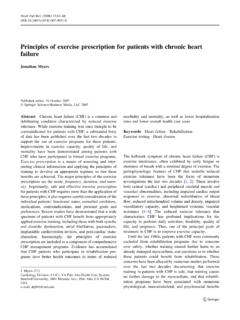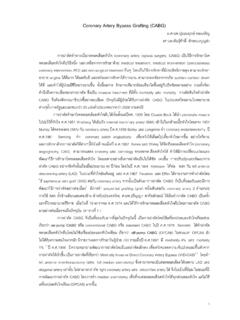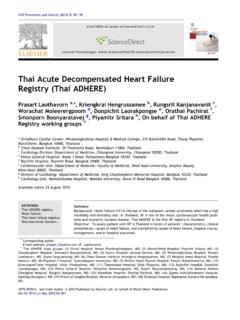Transcription of ECG INTERPRETATION:ECG INTERPRETATION
1 ECG INTERPRETATION :ECG INTERPRETATION : the basicsDamrong Sukitpunyaroj MDDamrong Sukitpunyaroj, MDPerfect Heart Institue, Piyavate HospitalOverviewOverview Conduction Pathways Systematic INTERPRETATION Common abnormalities in Critical Care Supraventricular arrhythmiasVentric lar arrh thmias Ventricular arrhythmiasConduction PathwaysConduction PathwaysConduction PathwaysConduction PathwaysP wave = atrial Interval = impulse from atria to ventriclesto complex = ventricular segment = isoelectric - part of wave = usually same directionT wave = usually same direction as QRS - ventricular Interval = This intervalQT Interval = This interval spans the onset of depolarisation to the completion of repolarization of the ventriclesof the Number of P s (atrial) R s (ventricular)
2 Per minute (6 second [30 squares] X 10 = minute rate).P rate: 8 x 10 = 80R rate: 8 x 10 = Regular or irregular. Map P-P and R-R hdtiltInterpretation3. P wave= present, 1 per QRS, shape, duration, P-R interval= length ( - sec = <1 big square), QRS= duration ( - ), voltage, q or Q waves6. ST Segment= shape, isoelectric with PR segmentInterpretationInterpretation7. T wave= shape, direction8. QT interval= length (R-R/2 or QTc< sec)Abnormalities: Supraventricular arrhythmias Atrial Fibrillation Atrial Flutter Supraventricular Tachycardia (SVT)Abnormalities: Vtilhthi Premature Ventricular Complexes (PVCs)Ventricular arrhythmias Ventricular tachycardia (VT)Conduction PathwaysConduction PathwaysSupraventricular Narrow QRS complexVtilVentricular Wide QRS complexAbnormalities: atrial fibrillationRhythm: IrregularRate: A: 350 650; V: variesP: poorly definedP-R: N/AQRS: narrow complexS-T: normalT: normalQ-T: normalAbnormalities: atrial flutterRhythm: Regular / IrregularRate: A: 220 430.
3 V: <300 (2:1, 3:1 or sometimes 4:1)P: Saw toothed appearance P-R: N/AQRS: narrow complexS-T: normalT: normalQ-T: normalAbnormalities: supraventricular tachycardia (SVT)Rhythm: RegularRate: >100P: not visibleP-R: not definedQRS: narrow complexS-T: depression (sometimes)T: normalQ-T: prolonged (sometimes)Abnormalities: premature ventricular complexesExamplesExamplesExamplesExample sECG INTERPRETATION :ECG INTERPRETATION : 12 LeadOverviewOverview Lead Placement Axis Common abnormalities in Critical Care Heart blockB ndle branch blocks Bundle branch blocks Life threatening arrhythmias Lead PlacementLead PlacementV14th ICS i ht tV1 = 4th ICS right sternumV2 = 4th ICS left sternumV3= midway between V2V3 = midway between V2 and V4V4=5th ICS midclavicularV4 5th ICS midclavicularV5 = between V4 and V6 anterior auxiliary lineV6 = midauxillary line lateral to V4 and V5 Lead PlacementLead Placement Electrical activity towards = Electrical activity away = Lead PlacementLead PlacementAxisAxis The direction of an ECG waveform in the frontal plane measured inplane measured in degrees Represents the flow of pthe majority of electrical activity NllhQRS Normally the QRS
4 Complex is measured AxisAxis Each lead has its own axisLead PlacementLead PlacementCh t L dStandard Leads (bipolar) I - lateral wallChest Leads (unipolar) V1 - septal wall V2septal wall II - inferior wall III - inferior wall V2 -septal wall V3 - anterior wall V4-anterior wallAugmented leads (unipolar) V4 -anterior wall V5 - lateral wall V6-lateral wall aVR - no mans land aVL - lateral wallV6 lateral wall aVF - inferior wallLead PlacementLead PlacementNo-mans land, inferior, lateral, anterior, septal, Abnormalities: bundle branch blocks QRS widened, greater than secs Change in axis Difficult to interpret ECG Right or Left Normal P wave Followed by a T waveAbnormalities: right bundle branch blocks Indicates conduction problems in the right side of the heartthe heart May be normal in healthy peoplepeople R wave in V1, ie two R waves in V1in V1 Q wave in V6 Lead V1cats earsLead V1 cats earsAbnormalities: left bundle branch blocks Always indicates heart disease, usually of the left side of the heartside of the heart Hard to interpret an ECG with LBBBLBBB Lead V1 Q wave and an S wavewave Lead V6 an R wave followed by another R wavey Lead V6 Rabbit earsAbnormalities: heart block SA block (exit block) 1stdegree AV block 2nddegree AV block Wenckeback (type I)Mobit (t pe II) Mobitz (type II) 3rddegree AV blockAbnormalities: heart block SA blockAbnormalities: heart block 1stdegree AVAbnormalities.
5 Heart block 2nddegree AVWkbkWenkebackMobitzAbnormalities: heart block 3rddegree AVAbnormalities: life threatening arrhythmias Ventricular Tachycardia Ventricular Fibrillation AsystoleAbnormalities: life threatening arrhythmias - VTAbnormalities: life threatening arrhythmias - VFAbnormalities: life threatening arrhythmias AsystoleExamplesExamplesExamplesExamples







